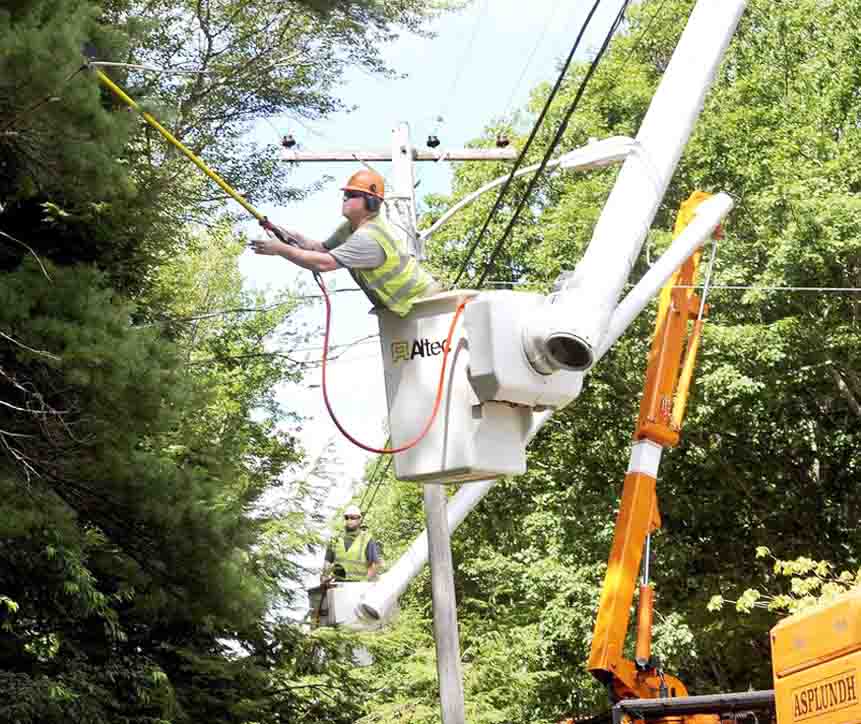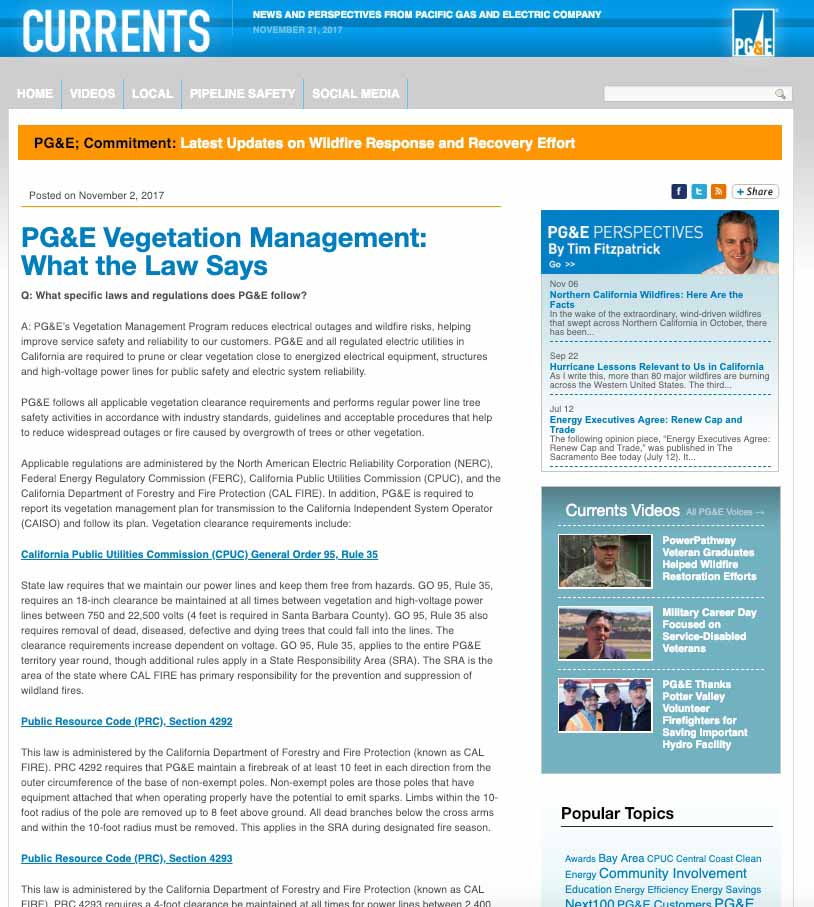
On Wednesday, the day after Pacific Gas and Electric officially filed for bankruptcy protection, a federal judge berated the company for wildfires started by their electrical distribution equipment.
“To my mind, there’s a very clear-cut pattern here: that PG&E is starting these fires,” Judge William Alsup said. “What do we do? Does the judge just turn a blind eye and say, continue your business as usual. Kill more people by starting more fires.'” And later, “Safety is not your number one thing”.
PG&E has been on criminal probation for years following the 2010 gas line explosion in the San Francisco Bay Area that killed eight people and destroyed 38 homes. Judge Alsup is overseeing the company’s probation.
Investigators have attributed more than 1,500 fires to PG&E power lines and hardware between June 2014 and December 2017, according to the Wall Street Journal (subscription).
Below is an excerpt from KCRA:
[Alsup] proposed earlier this month as part of PG&E’s probation that it remove or trim all trees that could fall onto its power lines in high-wind conditions and shut off power when fire is a risk regardless of the inconvenience to customers or loss of profit. Alsup said his goal was to prevent PG&E equipment from causing any wildfires during the 2019 fire season.
PG&E wrote in a court filing last week that the judge’s proposals would endanger lives, could cost $75 to $150 billion to implement, and require the hiring of 650,000 workers.
From the Merced Sun Star:
Alsup, however, was clearly frustrated by PG&E’s explanations. “I don’t buy that there isn’t enough people,” the judge said, adding that PG&E is moving too slowly and wasted billions paying dividends to shareholders instead of removing trees and improving its system.
What does California law require?
The California Public Resources Code section 4293e requires all vegetation to be removed that is within four to 10 feet of a power line, depending on the how many volts it is carrying. The Code also requires the removal of “dead trees, old decadent or rotten trees, trees weakened by decay or disease, and trees or portions thereof that are leaning toward the line which may contact the line from the side or may fall on the line.”
PG&E acknowledged this law and others in the November 2, 2017 edition of their “Currents” publication. The original copy on the internet has been removed and we were unable to find it — except on the Wayback Machine Internet Archive that was captured on November 20, 2017.

Our Opinion
It seems odd, to say the least, that PG&E now seems surprised and outraged that a judge is suggesting that the company “remove or trim all trees that could fall onto its power lines in high-wind conditions”, which is exactly what the law requires, and which was acknowledged by the company in their newsletter three weeks after their electrical system started a dozen fires in Northern California on October 8, 2017, according to CAL FIRE investigators. The agency is also looking into PG&E power line equipment failures that may have caused the Camp Fire on November 8, 2018. Over 40 people died in the Northern California fires, and 86 perished in the Camp Fire which also destroyed more than 14,000 homes.

Sadly there is a problem with development in the forested areas which are usually in valleys. These valley areas are constantly under development pressure. City and county commissioners repeatedly give variances allowing development in areas that should remain undeveloped. Private property rights is advocated above the general greater good. single roads lead into these valleys. Escape is complicated by evacuating livestock along with people. How can a single road serve as an escape when it gets immediately clogged with vehicles?
So it gets back to allowing development in vulnerable areas. Power line failure is a symptom of the problem. Not to say that the power companies are not also at fault.
Bend Oregon has just successfully limited density in the logged area of second growth on the west side of town.
These are great points….what I’ve never seen in the discussion (food for thought) is the idea of overhauling the entire power line design system within WUI areas…think of a secure mini pipeline just a few feet off ground containing all the lines necessary. No wind exposure. These projects would fit nicely into the up and coming new green deal being explored….
However…I still can’t help but think this is simply an issue of overdevelopment in the wildlands (not just in CA). If it’s not power line failure it’s a propane tank, cigarette, or burnt turkey in the oven that causes a house fire which spreads to wildland. Do The developers and zoning commissions who pushed these homes (along with power lines) to be built in the first place bear no responsibility? The clock is ticking for places like Ely, MN or Bend,OR….
Like the other comments this is not a black and white situation. The idea that the utility company must “remove or trim all trees that could fall onto its power lines in high-wind conditions” sounds simple enough…. but in practice is almost impossible. I was a forester for a utility company for a while so I know people complain about power outages (or worse!) due to tree contact, BUT people also complain when the power company trims the trees. Depending on the species of trees you might need to 50-100 ft. or more on both sides of the lines so no tree could possible hit the wire! I think the general public would freak if that were to happen, let alone the cost to get that done.
There is no simple solution.
It seems like this issue is multi-dimensional: lots of parties have intertwined responsibilities. The County Commissioners and Planning Boards that approve the building permits; the State Public Utility Commissions that oversee the Utility Companies; the Utility Companies that fail to redeem their roles in maintenance if power lines; the homeowners that ignore common sense and known science in the design of their homes and landscaping; the banks that finance the home loans; the fire agencies that don’t scream “no way” loud enough because of local pressures; the Insurance companies that insure “at risk” properties; all bear a portion of the blame. And it’s not just in California: the same can be said in most Western States, and even in the Eastern States with WUI areas.
Having spent the majority of my life in Northern California, specifically the Sierra Foothills near Sacramento, I know of several situations where accessibility to many power lines have been blocked and even booby trapped by private landowners.
I do not condone, the situation on either side of the table. But should that guy trying to put food on his table risk being hurt or killed by a landowner who thinks he can get away with it.
As a firefighter for over 30 years, in 5 different states, I can say without a doubt that many, many people in the rest of the country thinks that California belongs in the Looney bin.
And this constant infighting just proves their point.
There is no doubt that PG&E should do a better job in CA managing there energy systems HOWEVER there are a lot of other factors, in my opinion, involved here. After spending most of my career fighting fire in CA, I’ve come to the conclusion that there is no other place in the USA where development has been allowed to happen in such haphazard manner for so many people. Most rural counties in northern CA over the past 20-30 years or so have become the destination or people fleeing the high cost of living and overcrowding in the major population areas, and local governments have not been able to keep pace with needed infrastructure development. This development spilled over into my home state of Oregon and sent me packing off to New Mexico. I paid off my Mortgage and sent my kids to college on my extra fire earnings in CA. Who pays for upgrading and proper maintenance of infrastructure, including power lines? All of us do one way or the other.